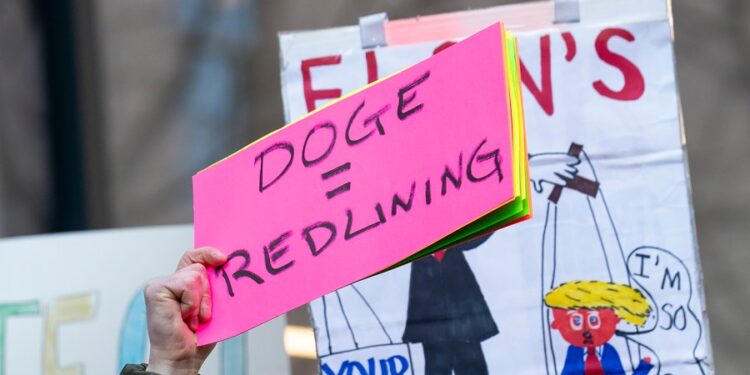
Elon Musk’s Department of Government Efficiency (DOGE) has caused uproar almost from the moment of its inception.
DOGE is not an official government department, despite its name. Only Congress can create new departments. But DOGE is an effort by President Trump and Musk to radically reform — and reduce — the size of government.
At one time, Musk had suggested it was possible to cut $2 trillion from the federal budget. More recently he has indicated that half of that figure would be more realistic.
But even accomplishing $1 trillion in cuts would require massive cuts to government services and to its payroll.
The idea is welcomed by fiscal hawks, MAGA supporters and Musk’s own legion of fans.
But critics say DOGE is going to hurt millions of Americans by axing programs that they need, or the personnel that support them.
They also express concern about conflicts of interest, given that Musk’s companies have billions of dollars in federal contracts.
Here are the five biggest controversies so far.
Access to Treasury Department — and taxes?
Perhaps no single DOGE-related furor has captured the public imagination so much as his team’s access at the Treasury Department.
The issue is whether Musk and his acolytes have access to individual taxpayer data, which is subject to strict disclosure rules. At its most basic, the question is, “Can Elon Musk see your tax returns?”
The row has grown more intense in recent days after several news organizations reported that DOGE personnel had sought access to a specific system — the Integrated Data Retrieval System, or IDRS — which is home to some of the most sensitive information.
The Washington Post referred to IDRS as a system that “includes detailed financial information about every taxpayer, business and nonprofit in the country.”
The Post also noted that the system “enables tax agency employees to access IRS records — including personal identification numbers — and bank information.”
A Trump administration official told the Post this effort was being carried out “legally and with the appropriate security clearances” in the name of bringing “much-needed efficiency” to the federal government’s workings.
This is only the latest development in the saga of DOGE and the Treasury Department.
Last week, U.S. District Judge Jeannette Vargas extended an earlier restraining order curtailing DOGE’s access to the Treasury Department’s payment systems.
Musk had previously targeted another judge who ruled against his quasi-department in the matter, calling for U.S. District Judge Paul Engelmayer’s impeachment.
Hollowing out USAID
The United States Agency for International Development (USAID) is a shell of its former self after DOGE got to work.
The agency’s management of roughly $40 billion was a particular target of Musk, who contended that far too much of the money went astray, either through fraud or because of misplaced priorities.
Musk has said that USAID is “beyond repair,” “a ball of worms” and an agency that he had spent one weekend “feeding … into the wood chipper.”
Musk also contended in early February that he had gotten Trump’s agreement to “shut it down.”
An official shutdown would be a matter for Congress to decide. But the Trump administration has done everything short of that to neuter the agency. Until recently, USAID had about 14,000 employees. It is now projected to have fewer than 300.
USAID’s defenders argue that the moves to hollow out the agency are both callous and shortsighted.
Samantha Power, who led the agency under former President Biden, wrote in a New York Times op-ed that the de facto collapsing of USAID is set to be “one of the worst and most costly foreign policy blunders in U.S. history.”
Power also contended that Musk and his allies had “imperiled millions of lives, thousands of American jobs and billions of dollars of investment in American small businesses and farms while severely undermining our national security and global influence — all while authoritarians and extremists celebrate their luck.”
The administration’s actions on USAID are the subject of several legal challenges.
Federal firings and the buyout offer
The Trump administration’s offer to buy out federal employees officially emanates not from DOGE but from the Office of Personnel Management.
But it has Musk’s fingerprints all over it — even in the way the subject line of the email that made the offer, “Fork in the Road,” echoed a similar email he sent to employees of the social platform X soon after taking over the company.
In the government case, federal workers were offered payment of their salaries and retention of their benefits until the end of September if they swiftly committed to resigning.
The administration has said about 75,000 employees took the offer before it closed on Feb. 12 — roughly 4 percent of the federal workforce.
Labor unions had sought to stop the program in the courts, but in the end they only briefly froze it.
Opponents argue that it’s not even guaranteed the workers will get their money, as Congress has not appropriated funding for that long or for the purpose of a buyout.
The buyout email had warned of forced cutbacks to come, telling government workers in a related document that “the federal workforce is expected to undergo significant near-term changes.”
So it has proven.
Reuters reported that the administration began firing thousands of workers last Thursday. The news agency reported that the Department of Veterans Affairs had laid off more than 1,000 employees who were in their probationary period and that the U.S. Forest Service was on the cusp of firing 3,000.
There has been little official word on how many workers have been fired in total, but the latest figures available, from roughly one year ago, indicated that around 220,000 federal workers were at less than 12 months on the job at that point.
Probationary workers appear to be the first group targeted for layoffs.
Putting a stop to the CFPB
The Consumer Financial Protection Bureau (CFPB) grew out of the ashes of the 2008 financial crisis, intending to put financial institutions under greater scrutiny and to guard the interests of their customers.
But it was swiftly put under DOGE’s scrutiny instead, with Musk at one point posting on social media “CFPB RIP.”
In short order, DOGE helped to halt the bureau’s work.
The official move came from Russell Vought, a Trump loyalist who now presides over the Office of Management and Budget.
Vought instructed CFPB employees earlier this month to simply stop performing “any work tasks.”
The bureau has an unusual funding arrangement — its money comes from the Federal Reserve, not from a specific congressional appropriation — but Vought said that the next tranche of funding would simply not be drawn down.
Putting a stop to the CFPB’s work could have a payoff for Musk’s businesses, as critics were quick to note.
X has recently advanced plans for its own mobile payments service, apparently to be called an “X Money Account.” According to NPR, this service “would be directly regulated by the [CFPB] under expanded oversight powers it had finalized late last year.”
In other words, Musk’s team was in effect rendering impotent an agency that had the power to regulate elements of his business.
Delving into the vaults at Fort Knox?
As if he hadn’t made enough headlines with many of the moves listed above, Musk suggested on Monday that he would be putting Fort Knox under the microscope.
The Kentucky facility is synonymous with the vast amount of gold reserves stored there.
“Looking for the gold at Fort Knox,” Musk wrote on X on Monday.
Keying off a post from Sen. Mike Lee (R-Utah) about allegedly being denied access to Fort Knox, Musk added, “Who is confirming that gold wasn’t stolen from Fort Knox? Maybe it’s there, maybe it’s not. That gold is owned by the American public! We want to know if it’s still there.”
Fort Knox famously does not allow visitors.
It was unclear exactly what Musk meant by his social media postings — whether he would demand some kind of auditing of the gold held in Kentucky or whether he was merely indulging his penchant for stirring controversy and publicity.






